
It has often been difficult to trace the development of early children’s literature, widely practiced in the form of stories and songs for children, before printing was invented. Even after the spread of literacy and publishing systems, it took a while for societies to produce books specifically designed for children. In Europe, early children’s books were mere adaptations of stories intended for adults. Tracing the history of children’s literature in Iran is just as difficult. For in spite of the fact that a large sum of traditional Persian literature consisted of tales with didactic purposes, the absence of printing machinery, scarcity of fine manuscripts which were in possession of the nobility, and low rate of literacy made it more improbable for common children to access these stories by any means other than oral taletellers. A rare and recent attempt to undertake research on the subject started in 1997 by a team of experts including M. H. Mohammadali and Zohreh Ghaeni; a painstaking project that ended in ten volumes of historical enterprise and about 7000 pieces of archived documents, the oldest of which dates back to 1847.
Currently Tehran Museum of Contemporary Arts is hosting an unprecedented public exhibition with the same concerns. Karnameh, Visual Culture of Iranian Children: 1950-1980, an ambitious project by The ABProjects and Studio Kargah, surveys through more than three decades of visual creation for children against the cultural and socio-political backdrop of the second half of the 20th century. Running from 25 May to 15 August 2016 at TMOCA, the exhibition and the accompanying bilingual book of the same title (an archival-research volume of about 441 pages) present a diorama of Iranian children’s literature and arts in the 20th century as they fluctuate between traditional practices and pieces affected by the social milieu of modernity. A joint-project curated by Ali Bakhtiari, Yashar Samimi Mofakham, and Peyman Pourhossein, Karnameh was initiated a few years ago with the goal of archiving the visual heritage of Iranian children after the 1920s. The book strictly follows a chronological order which makes it favorable for researchers, whereas the exhibition’s setting is less restrained and offers options for visitors of various ages from children to elderly. A journey through nine galleries familiarizes the viewer with early illustrations for educational books dating back to 1920s, photo documentaries of the 20th century modernized schools in Iran, as well as the pioneers of image-making and entertainment productions, namely animations and films.
Upon entrance to Gallery One, the visitor is exposed to full-height transparent calendars beginning with Colonel Reza Khan’s march to Tehran and publicization in 1921, and ending with the formation of the Literacy Movement in Iran and commencement of Iranian Oral History Project at Harvard in 1981. The main focus of all the nine galleries is, however, on a thirty-year span of time between 1950s and 1980s. “1953 is a pivotal year in the socio-political history of Iran,” says senior curator Ali Bakhtiari, “Following the implantation of Point Four Programme of Truman in Iran and the 1953 Coup D’etat, Iranian children’s literature undergoes major transformations along with other cultural arenas of the country.”
The geopolitical situation of Iran in the 20th century kept the country in a constant state of flux. “When the Second Pahlavi Dynasty came to power following World War II, Iran, under the influence of the cold war, became a country where the governments of the United States, Britain, and the Soviet Union spent much effort in affecting the culture and public opinion of its population.” They had realized that “in the future, supporting the masses may become a determinant factor for any government wishing to rule Iran.” One of the main ways for breaking up a culture is influencing its younger generation, and indoctrinating it with a new culture.” (Karnameh 146) Accordingly, one of the main programs of the United States during the cold war was the export of cultural products aimed at children and young adults. Walt Disney movies, television programs, American books and magazines, comics, literature, etc. were all part of this political agenda (148). This is the focal point of Galleries Two to Four, respectively titled “Iran: New Times”, “Forerunners: 1950s”, and “East and West”.
While Gallery 5, titled “Books Made in Iran,” traces the gradual growth of middle class in the 1960s, import of printing machinery, and call for more appropriate reading materials, Gallery 6 relates the “Birth of the Institute”(1) in 1965 and its breakthrough impact on generations of Iranian children across the country. Gallery 7 is a tribute to a prominent figure in the modern history of illustration: Farshid Mesghali. Gallery 8 themed on Religious Illustration may stand out at first, but as you move on in pursuit of visual signs of social flux in Iran mirrored in the works produced for children, you may notice that Gallery 8 featuring works by religious publishers Payam Islam and Meraj is in fact a harbinger of major transformations underway: the 1979 Revolution. Gallery 9 introduces the “post-revolutionary” New Era and the new models it has to offer: The Revolutionary Hero and the Martyr Hero are dominant figures in the posters, books, and films collected in this gallery where you cannot help responding to sudden change of setting and colors.
This is perhaps the only flaw of the exhibition: the exhibition’s meticulous effort to present a ‘truthful’ image of the dominant visual culture of each era has led to negligence, even suppression, of other (minor) voices. This being the problem with any linear, taxonomic and monolithic views of social history, is reflected in collection and selection of covers of popular, and often state-budgeted media and magazines such as “Keyhan Bacheha,” and subsequent elimination of actual underground or unofficial ‘reads’ of common children. One major factor missing from this strategy is the ‘readership’ or reception of publications for children. Do children, as well as their family units, passively consume publications promoted by dominant ISAs? Did we ever have resistant child readers, or alternative reading materials that would justify social resistance to radical modernization and succumb to the bosom of ideological didactism? These are the questions that any art historian should ask before roaming from one gallery to the next.
-
The Institute: the state-funded Institute for the Intellectual Development of Children and Young Adults (IIDYCA)
[huge_it_gallery id=”4″]


Leave a Reply